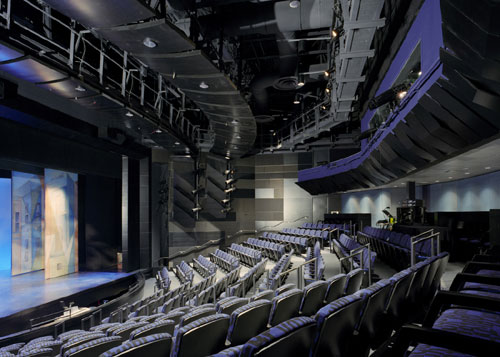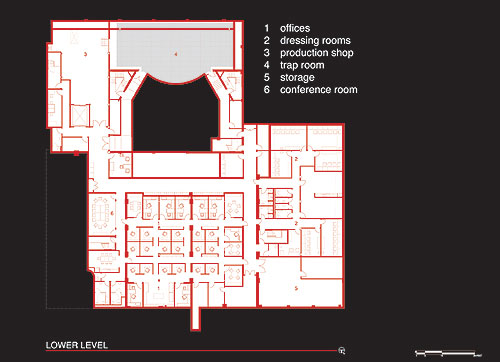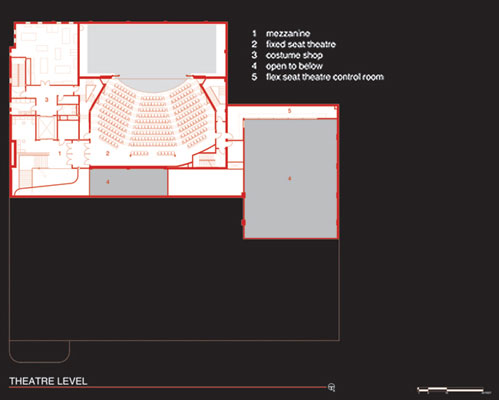Atlas Performing Arts Center
An abandoned movie house becomes a performing arts center and brings life back to its neighborhood.

Photo © Michael Moran

Photo © Michael Moran

Photo © Michael Moran

Courtesy of CORE architecture + design

Courtesy of CORE architecture + design

Courtesy of CORE architecture + design

Courtesy of CORE architecture + design







Architects & Firms
Washington, DC
History, if left forgotten, can fall perilously to the wayside. Such was the fate of the Washington, D.C. landmark Atlas Theater Cinema until a foundation sought to transform the former 1930’s movie house and adjoining vacant storefronts into a new, state-of-the-art 58,000-square-foot performing arts facility. The architect combined five structures through a four-year, extensive adaptive reuse and renovation that carefully preserved key historical elements and brought new life to the street front of a once bleak and neglected corridor.
A complex program called for two state-of-the-art theaters, including a 280-fixed-seat space and a 250-person flexible-seat black box, each with computerized lighting and sound equipment control rooms. Additionally, the foundation wanted three dance studios, two lab theaters, a production shop and administrative support spaces, all within the original site footprint and an extremely tight construction budget of $20 million.
Throughout the main level public space, materials, color, balance, scale, texture, and pattern are blended to create welcoming, comfortable, contemporary, and vibrant spaces. Cost effective, durable, and interesting products such as carved MDF wall treatments and architectural mesh is utilized for impact, ease of maintenance, and harmony between the existing and new finishes. Lighting design was orchestrated to highlight the architectural and interior design elements, and unique sculptural shadow signage for the two large theater spaces adds drama and distinction to guide patrons through the space.
At every turn, history and contemporary design meld to create visual interest. A former exterior alleyway brick wall was integrated as the interior wall in the promenade; the basement and office spaces are configured around exposed concrete footings with evidence of excavation. Original air return grilles from the movie house were painstakingly restored and mounted in the promenade hall, in contrast to the contemporary finishes and sweeping curves of the ceiling overhead.
Today, the H Street corridor is more often referred to as the “Atlas Arts District.”
PeopleArchitect: CORE Architecture + Design 1010 Wisconin Avenue NW, #405 Washington, DC 20007 P: 202.466.6116 F: 202.466.6234 Web: coredc.com
Personnel in architect's firm: Dale A. Stewart, AIA, Project Principal, Team Lead; Peter F. Hapstak, AIA, IIDA, ISP, Design Principal; David Cheney, AIA, Project Manager; Kathleen Claire Ngiam, Senior Designer; Adriana Radulescu, Project Architect; Brent Phister, Project Architect; Monier Baraket, Project Architect
Interior designer: CORE Architecture + Design
Lighting: MCLA Inc. Shen Milsom & Wilke, Inc. (acoustical)
Other: Set design: Tony Cisek Theatre Lighting: Dan Covey Theatre sound: Scott Burgess
General contractor: Tishman Construction Corporation of DC 1150 18th St. NW Washington, DC 20036
Photographer: Michael Moran Photography P: 212.334.4543
Renderer: CORE architecture + design
CAD system, project management, or other software used: ArchiCAD
|
ProductsExterior Cladding Masonry: Historic preservation / restoration
Metal / glass curtainwall Historic preservation / restoration EIFS, ACM, or other: Dryvit Glass film: Pointer Crosse Marquis: Fingles Metalworks, Inc. Letterbox: Belsinger Signs
Windows Wood: Historic preservation / restoration Steel: Historic preservation / restoration Aluminum: Historic preservation / restoration
Glazing Glass: Existing & repaired and refurbished / historic preservation / restoration
Doors Entrances: all doors and existing hardware was repaired and rebuilt.
Hardware non-specific, various brands for all
Interior finishes Acoustical ceilings: Armstrong ceiling tiles (perforated metal in the soffit of Lang Theater); Decoustics clouds in Great Hall with curved panels in Promenade. Paints and stains: Benjamin Moore Paints Wall coverings: Marotte Carved MDF panels for Great Hall; Cambridge architectural mesh at monumental stair. Paneling: custom Floor and wall tile: Granite Fiandre, Grey Ceramic w/ GSPAG Blue Accents and stainless steel in Great Hall / Promenade; Daltile in bathrooms; Innovative Stone, Black Quartz, on Monumental Stair; 2 layers of masonite for stage and dance studio floors. Carpet: Interface FLOR, Masland
Furnishings Office furniture: Custom-built workstations made of MDF with Wilson Art laminate with painted drywall dividers. Reception furniture: Frank Gehry for Heller Fixed seating: Series USA, NYC Upholstery: Maharam for theatre seating and acoustic wall panels in Lang Theater
Lighting: Interior ambient lighting: stock Downlights: Exterior: Existing / rebuilt and repaired / Historic preservation
Conveyance Elevators / Escalators
Plumbing American Standard
Add any additional building components or special equipment that made a significant contribution to this project Plaster Panels restoration: Goldleaf Studios
|








